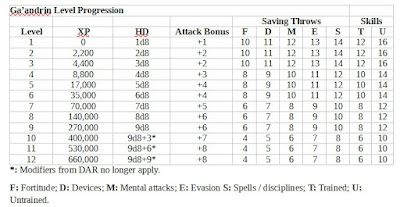A brief caveat:
Atlantis: The Antediluvian World is not a work of fiction – at least not of an
intentional kind. At the time it was published (1882), it was presented as speculative archeology, however dubious that claim might have been, even by the standards of its own time. More to the point, its author, Ignatius L. Donnelly, did not believe he was writing fiction but rather that he was advancing "several distinct and novel propositions" regarding "an Atlantic continent … known to the ancient world as Atlantis." He believed this so strongly that he continued to advance his theses for the remainder of his life, writing a sequel in 1883 and inspiring countless other writers in the ensuing decades.
It's largely on this basis that I'm including it as this week's Pulp Fantasy Library post. Considered purely in terms of its influence on later fiction, Atlantis: The Antediluvian World is an important product of human imagination and creativity, easily on par with the avowedly literary efforts of H.P. Lovecraft, or J.R.R. Tolkien. Indeed, if you've ever read a story involving Atlantis, whether it be Clark Ashton Smith's tales of Poseidonis, Robert E. Howard's Kull yarns, or even the adventures of Aquaman, to cite just a few, you owe a debt to Ignatius Donnelly and his obsession with proving that Atlantis was not only real but "the region where man first rose from a state of barbarism to civilization."
Donnelly himself is a fascinating fellow, in the way that only men from the past seem to be. Born in Philadelphia in 1831, he became a lawyer and moved to the Minnesota territory, where he attempted to found a cooperative farm and utopian community with several others. Though the farm failed, leaving him in debt, Donnelly managed to use his rhetorical skills to become Minnesota's second lieutenant governor after statehood. Later, he was elected to the U.S. House of Representatives and to seats in both houses of Minnesota's state legislature. As a politician, he advocated for women's suffrage, a progressive income tax, and an eight-hour workday, among many other causes radical for their time. And, of course, he was also an advocate of the belief that Atlantis "is not a fable, as has been long supposed, but veritable history." Like Whitman, Donnelly contained multitudes.
Atlantis is a lengthy and ponderous book, divided into five parts, each consisting of six or more chapters. The tome begins with a chapter in which Donnelly lays out "the purpose of the book" by asserting the following theses:
1. That there once existed in the Atlantic Ocean, opposite the mouth of the Mediterranean Sea, a large island, which was the remnant of an Atlantic continent, and known to the ancient world as Atlantis.
2. That the description of this island given by Plato is not, as has been long supposed, fable, but veritable history.
3. That Atlantis was the region where man first rose from a state of barbarism to civilization.
4. That it became, in the course of ages, a populous and mighty nation, from whose overflowings the shores of the Gulf of Mexico, the Mississippi River, the Amazon, the Pacific coast of South America, the Mediterranean, the west coast of Europe and Africa, the Baltic, the Black Sea, and the Caspian were populated by civilized nations.
5. That it was the true Antediluvian world; the Garden of Eden; the Gardens of the Hesperides; the Elysian Fields; the Gardens of Alcinous; the Mesomphalos; the Olympos; the Asgard of the traditions of the ancient nations; representing a universal memory of a great land, where early mankind dwelt for ages in peace and happiness.
6. That the gods and goddesses of the ancient Greeks, the Phoenicians, the Hindoos, and the Scandinavians were simply the kings, queens, and heroes of Atlantis; and the acts attributed to them in mythology are a confused recollection of real historical events.
7. That the mythology of Egypt and Peru represented the original religion of Atlantis, which was sun-worship.
8. That the oldest colony formed by the Atlanteans was probably in Egypt, whose civilization was a reproduction of that of the Atlantic island.
9. That the implements of the "Bronze Age" of Europe were derived from Atlantis. The Atlanteans were also the first manufacturers of iron.
10. That the Phoenician alphabet, parent of all the European alphabets, was derived from an Atlantis alphabet, which was also conveyed from Atlantis to the Mayas of Central America.
11. That Atlantis was the original seat of the Aryan or Indo-European family of nations, as well as of the Semitic peoples, and possibly also of the Turanian races.
12. That Atlantis perished in a terrible convulsion of nature, in which the whole island sunk into the ocean, with nearly all its inhabitants.
13. That a few persons escaped in ships and on rafts, and, carried to the nations east and west the tidings of the appalling catastrophe, which has survived to our own time in the Flood and Deluge legends of the different nations of the old and new worlds.
To anyone with even the slightest interest in the subject of Atlantis – or the decades of pulp fantasy musings on the subject – none of these propositions is the least bit surprising. At the time, though, they were bold and original, if not at all historically well-founded. Atlantis was a success for Donnelly and its ideas were disseminated widely, so much so that they now form an important substrate of both popular culture and esoteric beliefs.
Growing up, the mother of two friends of mine, with whom I first began playing RPGs, had an extensive library of books that, at the time, we called "New Age." Among them was a copy of Atlantis: The Antediluvian World, alongside the works of authors inspired by it, like Edgar "The Sleep Prophet" Cayce and various Theosophists. I'd sometimes take the books off her shelves and peruse them, looking for interesting sections that might inspire D&D adventures. Even as a kid, I found most them more than a little ridiculous, but Donnelly's book held my attention, perhaps because of its author's self-seriousness and obvious enthusiasm for the "revelations" he is imparting to his readers. It's not difficult to see why it caused a stir in its day or why its central theory, however implausible, continues to maintain a hold over the popular imagination almost a hundred and fifty years later.


























